To plan a sensory-friendly Halloween night, focus on creating a calm environment by adjusting lighting and reducing loud noises. Choose costumes made of soft, breathable fabrics without flashing or noisy accessories. Schedule trick-or-treating early to avoid crowds and pick quiet neighborhoods. Offer sensory breaks with quiet zones and simple, engaging activities. Use visual supports and social stories to set clear expectations. If you want more tips on ensuring comfort and fun, keep exploring for helpful ideas.
Key Takeaways
- Create a calm environment with soft lighting, noise reduction, and sensory-friendly decorations to minimize overstimulation.
- Choose comfortable costumes with soft fabrics and minimal accessories, avoiding flashing lights and loud noises.
- Plan a route through quieter neighborhoods, scheduling trick-or-treating earlier to reduce crowd size and sensory overload.
- Incorporate sensory-friendly activities, visual schedules, and social stories to prepare children and set clear expectations.
- Establish designated quiet zones and breaks, and communicate sensory needs clearly to ensure a supportive and enjoyable experience.
Choosing the Right Costume and Accessories

When selecting a costume and accessories for a sensory-friendly Halloween, it’s important to prioritize comfort and safety. Choose costumes made from soft, breathable fabrics that won’t irritate sensitive skin. Avoid costumes with rough seams, itchy materials, or tight fits that could cause discomfort. For accessories, opt for lightweight, non-toxic items that won’t pose choking hazards or cause sensory overload. Steer clear of noisy or flashing lights, as they can be overwhelming. Instead, look for simple accessories that enhance the costume without adding discomfort or safety risks. Ensuring costume comfort helps your child feel more at ease, while accessory safety minimizes potential hazards. Using appropriate sensory-friendly materials can also help reduce overstimulation and create a more enjoyable experience. By focusing on these factors, you create a positive experience that fosters confidence and enjoyment during Halloween festivities.
Creating a Calm and Comfortable Environment
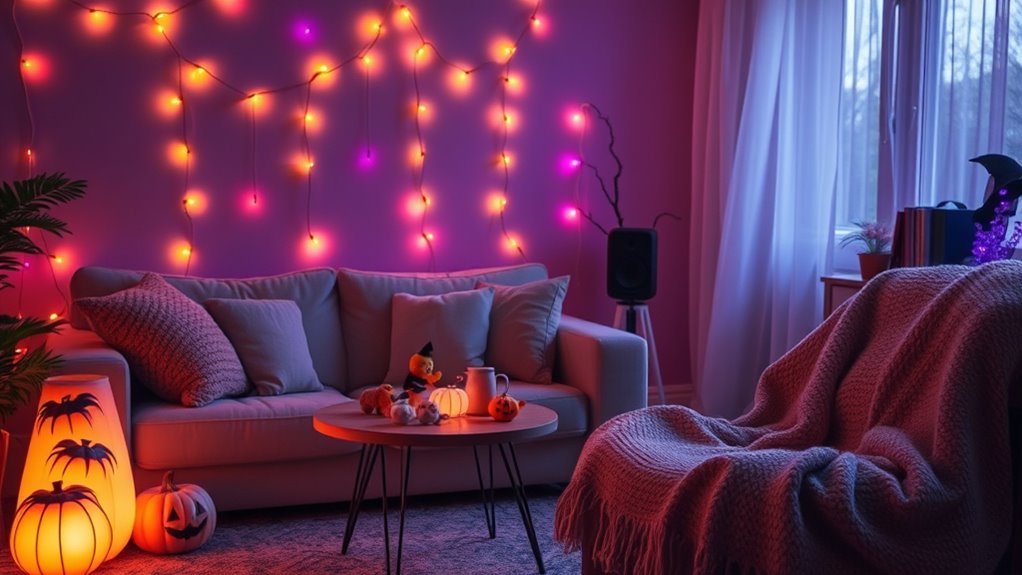
You can create a calming atmosphere by using dim lighting to reduce overstimulation and soft sounds to keep noise levels gentle. Choosing cozy costumes made from comfortable fabrics helps children feel secure and relaxed. Additionally, incorporating familiar scents or calming music can further enhance the sensory-friendly environment, making the experience more inclusive and enjoyable.
Dim Lighting Strategies
Have you considered how lighting can influence a child’s comfort during Halloween festivities? Dim lighting creates a calming atmosphere and reduces sensory overload. To achieve this, try these strategies:
- Use soft, warm bulbs instead of harsh overhead lights.
- Incorporate glow-in-the-dark decorations to add gentle illumination.
- Equip children with reflective accessories that catch light without increasing brightness.
- Limit the use of bright, flashing lights, opting for steady, subdued lighting instead.
These approaches help maintain visibility while avoiding overstimulation. Reflective accessories and glow-in-the-dark elements provide safe visibility without loud or bright lighting. Remember, the goal is to create a calm, inviting environment that keeps children comfortable and engaged throughout the night.
Understanding sensory processing can guide you in tailoring lighting choices to better suit children’s needs.
Soft Sound Choices
Creating a calm and comfortable environment for Halloween involves carefully selecting sounds that soothe rather than overstimulate. Sound therapy can help create a peaceful atmosphere, using gentle music or nature sounds to mask loud or jarring noises. Consider playing soft background music at a low volume to maintain a relaxing mood. Noise canceling headphones are a helpful tool for individuals sensitive to sudden or loud sounds, allowing them to block out overwhelming noise when needed. These headphones provide a sense of control and comfort, reducing sensory overload. By choosing soft, calming sounds and providing options to block out noise, you help create an environment where everyone can enjoy Halloween safely and comfortably. Incorporating practical tools rooted in evidence-based methods can further support a tranquil setting.
Cozy Costume Options
Choosing cozy costumes can make Halloween more comfortable and less overwhelming for sensitive individuals. Opt for soft fabrics like cotton or fleece that don’t irritate the skin. To guarantee safety and comfort, consider these ideas:
- Simple designs without bulky or restrictive parts
- Avoid costume accessories that could be choking hazards
- Use face paint instead of masks to maintain clear vision and easy breathing
- Choose footwear that’s comfortable and non-slip for safe walking
- Incorporate ergonomic designs into costumes to ensure ease of movement and reduce discomfort
Prioritize accessory safety by avoiding small, removable pieces that could be swallowed. Keep costumes loose enough for easy movement and breathable for comfort. These cozy costume options help create a calm environment, reducing sensory overload while still allowing you to enjoy Halloween festivities.
Adjusting Lighting and Sound Settings
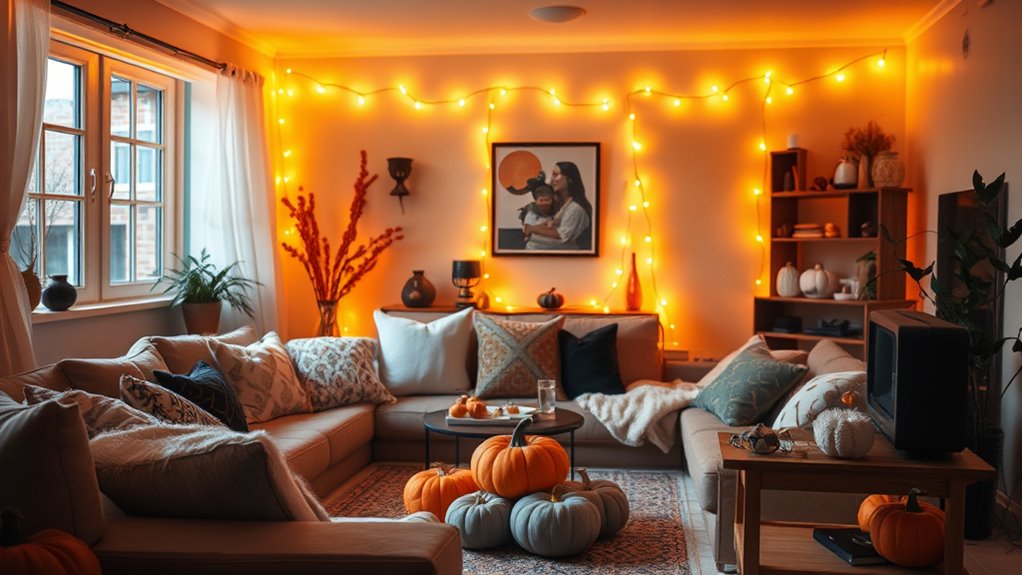
You can make the environment more comfortable by softening the brightness levels and using gentle lighting. Reducing loud noises helps create a calming atmosphere for everyone. Adjusting these settings guarantees a fun, sensory-friendly Halloween experience. Incorporating magical elements such as twinkling lights or soft music can further enhance the soothing environment.
Softening Brightness Levels
To make the Halloween experience more comfortable for sensory-sensitive guests, it’s important to soften the brightness levels of lighting and sound. You can achieve this through glare reduction and ambient lighting. Here are four ideas:
- Use dimmable bulbs or lamps to gently lower brightness.
- Incorporate soft, warm-colored lights instead of harsh whites.
- Avoid strobe or flashing lights that can cause discomfort.
- Position lights away from direct eye contact to reduce glare.
- Consider customizing lighting to match the needs of your guests and create an adaptable environment.
These adjustments create a calming atmosphere and prevent sensory overload. Reducing brightness and glare helps guests feel more at ease, while ambient lighting ensures visibility without overwhelming their senses. Keep the lighting subtle and cozy to foster a welcoming environment for everyone.
Reducing Loud Noises
Since loud noises can easily overwhelm sensory-sensitive guests, it’s essential to adjust sound levels and minimize sudden or intense sounds. Use noise reduction strategies like lowering volume settings on speakers and avoiding loud, abrupt effects. Incorporate soundproofing materials such as foam panels or thick curtains to dampen echo and external noise. Consider creating a quiet zone where guests can retreat if overwhelmed. Monitoring market trends can help you anticipate and further minimize noise disruptions during the event.
Using Gentle Lighting
Adjusting lighting is essential for creating a calming environment for sensory-sensitive guests. Soft, gentle lighting reduces overstimulation and helps everyone feel more comfortable. To achieve this, consider these ideas:
- Use fairy lights instead of bright overhead lights to create a warm, inviting glow.
- Dim any harsh lighting, focusing on low, diffused sources.
- Incorporate glow-in-the-dark costumes to add fun without excessive brightness.
- Avoid flashing or strobe lights, which can be overwhelming for sensitive guests.
- Consider utilizing catering and delivery services that offer healthy, sensory-friendly options to complement the calming atmosphere.
Planning Sensory-Friendly Activities and Games

Planning sensory-friendly activities and games involves choosing options that are engaging yet gentle on the senses. Focus on festive decorations that create a fun atmosphere without overwhelming sensory input. Use soft colors, gentle sounds, and simple visual effects to set the mood. Incorporate sensory-friendly treats into your activities, such as bite-sized snacks with familiar textures and flavors, to help children feel comfortable and included. Opt for tactile games like bean bag tosses or sorting activities that encourage participation without overstimulation. Keep activities short and flexible so kids can take breaks whenever needed. Attention in creative practice can be developed through mindful focus on activities, ensuring a calm and enjoyable environment. By thoughtfully selecting activities and decorations, you’ll create a welcoming environment where everyone can enjoy Halloween night comfortably and safely.
Managing Crowds and Creating Space for Breaks
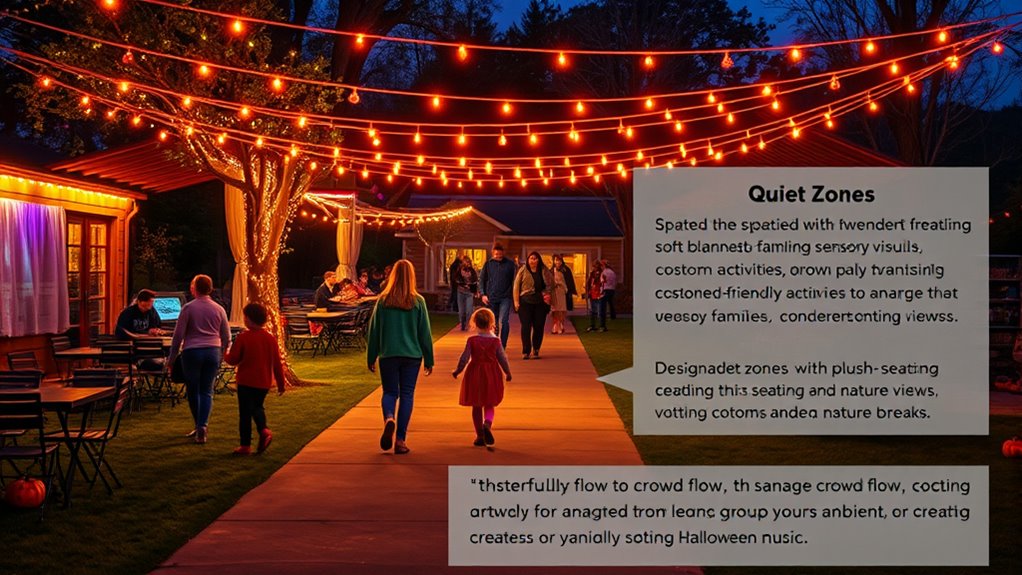
Managing crowds during Halloween night is essential to guarantee everyone feels safe and comfortable, especially for children with sensory sensitivities. Effective crowd management reduces overwhelm and helps create a positive experience. To do this, consider:
Managing crowds ensures a safe, comfortable, and enjoyable Halloween for everyone, especially sensory-sensitive children.
- Designating clear pathways to prevent congestion
- Setting up visible break zones where kids can pause and recharge
- Using barriers or signage to guide flow and limit overcrowding
- Scheduling specific times for trick-or-treating to spread out crowds
- Incorporating organization techniques to maintain a calm and controlled environment, making the night more enjoyable for all attendees.
These strategies give children space to decompress and avoid sensory overload. Break zones serve as safe spots for rest and calming activities. By actively managing crowd flow and providing designated areas, you ensure a smoother, more enjoyable Halloween night for everyone.
Selecting Appropriate Trick-or-Treating Routes and Times
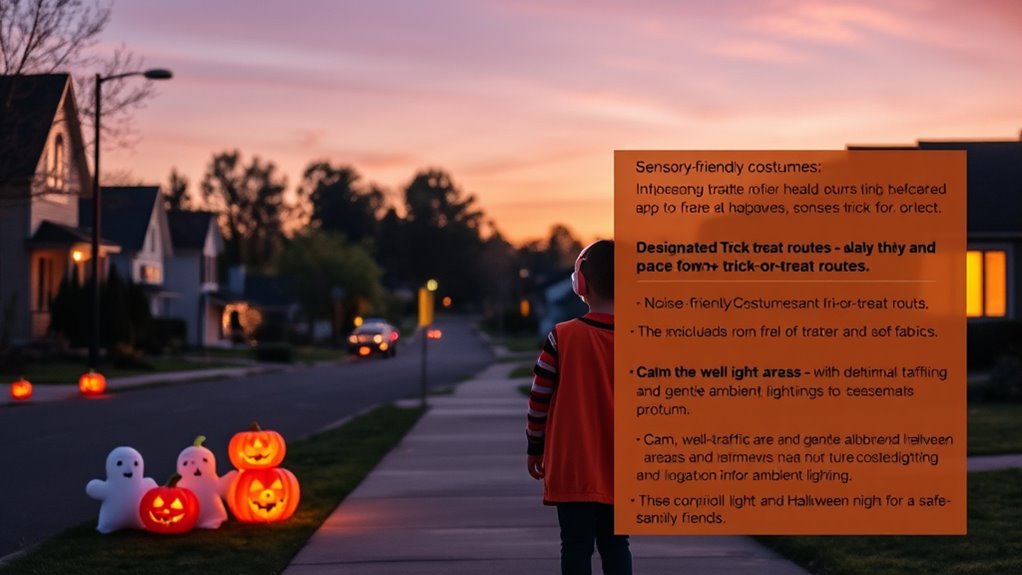
Choosing the right trick-or-treating routes and times can make a significant difference in creating a comfortable experience for children with sensory sensitivities. Opt for neighborhoods you’re familiar with, as this helps you anticipate traffic patterns, noise levels, and overall environment. Selecting routes through quieter streets with less foot and vehicle traffic minimizes sensory overload and enhances safety. Avoid busy intersections and areas with heavy traffic to ensure traffic safety. Consider trick-or-treating earlier in the evening when fewer people are out, reducing crowds and sensory input. Planning a route that avoids overly crowded or noisy areas helps your child feel more secure and enjoy the night. Additionally, using expert voice actors in your planning or communication can help convey important safety tips clearly and effectively. By choosing familiar neighborhoods and safe times, you create a more predictable, calming experience tailored to your child’s needs.
Preparing Visual Schedules and Social Stories
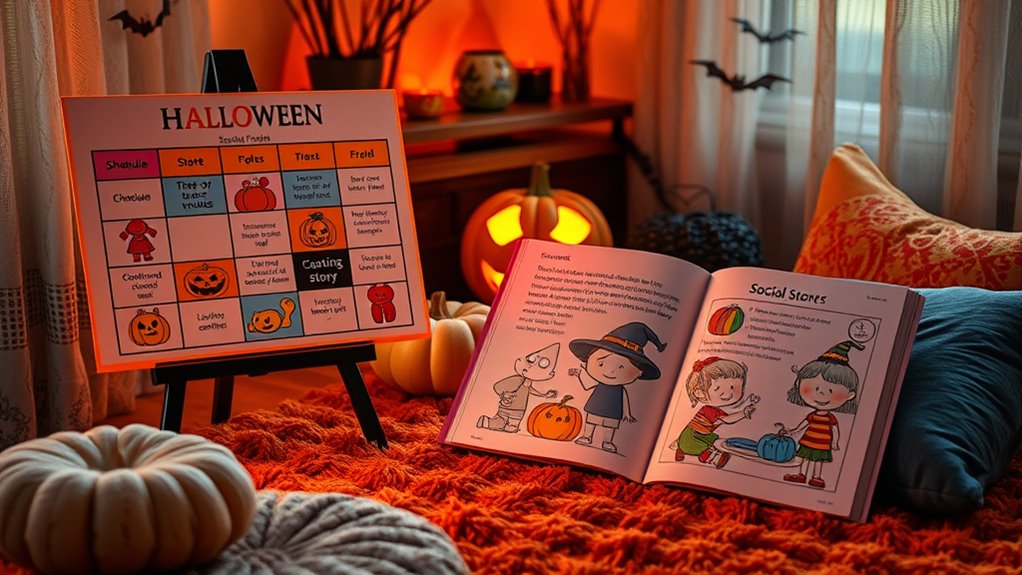
Creating visual schedules and social stories can help prepare children with sensory sensitivities for Halloween night by setting clear expectations and reducing anxiety. Focus on visual schedule creation by illustrating each step of the evening, such as dressing up, trick-or-treating, and returning home. When developing social stories, include simple language and relatable scenarios to explain what will happen, like meeting neighbors or visiting houses. Using visual aids can enhance understanding and engagement for children who benefit from visual supports. Consider these ideas: 1. Use pictures or icons to represent each activity. 2. Keep the social story brief and positive. 3. Review the visual schedule daily beforehand. 4. Personalize the social story with familiar settings and people. This preparation helps your child understand the flow of the night, easing worries and making the experience more enjoyable.
Communicating Your Needs and Setting Expectations
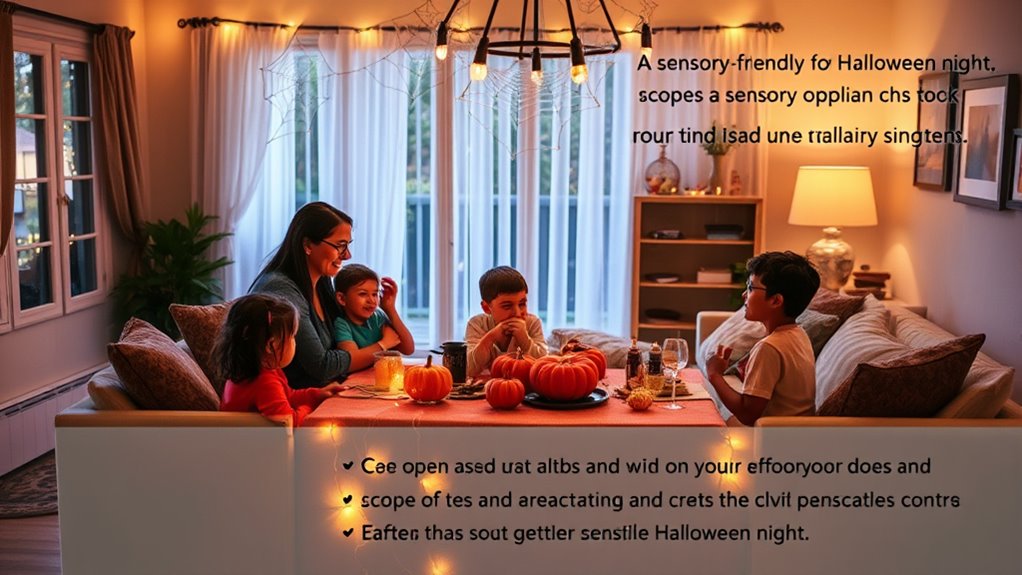
To guarantee your child’s needs are met and expectations are clear, it’s important to communicate openly about what will happen during Halloween night. Use clear communication to explain the plan, including which costumes are allowed, where trick-or-treating will happen, and how long the activities will last. Setting boundaries beforehand helps your child feel safe and prepared. Be honest about any loud noises, bright lights, or unfamiliar faces they might encounter. Encourage your child to voice their concerns or preferences, and listen carefully. Establishing these expectations early reduces surprises and anxiety. Remember, consistent and direct communication fosters understanding, making the night more enjoyable and comfortable for everyone involved. Additionally, understanding sensory sensitivities, such as projector features, can help you create a more accommodating environment.
Frequently Asked Questions
How Can I Involve My Child in Halloween Planning?
You can involve your child in Halloween planning by letting them choose or customize their costume, making it a fun activity that boosts their excitement. Encourage them to pick activities they enjoy, such as specific games or trick-or-treat routes, so they feel empowered and comfortable. By giving them a say in costume customization and activity selection, you help create a memorable, enjoyable experience tailored to their preferences.
What Are Safe Alternative Treats for Sensory-Sensitive Children?
Imagine your child’s delighted face when they find a bag of non-food treats waiting for them. Safe options like hypoallergenic snacks, small toys, or glow sticks are perfect for sensory-sensitive children. These treats avoid common allergens and loud noises, ensuring a fun, worry-free experience. By choosing thoughtful, safe alternatives, you create a Halloween night filled with excitement and comfort, making everyone feel included and celebrated.
How Do I Handle Unexpected Sensory Overload Situations?
When unexpected sensory overload happens, you should stay calm and use calming techniques like deep breathing or guiding them to a quiet space. Keep emergency preparedness in mind by having a set plan, such as a favorite comfort item or noise-canceling headphones ready. Reassure them with gentle words, monitor their reactions, and remove them from overwhelming stimuli if necessary, ensuring they feel safe and supported throughout the situation.
Are There Community Resources for Sensory-Friendly Halloween Events?
Yes, you can find community resources for sensory-friendly Halloween events by checking local community event listings and visiting sensory-friendly venues. Many organizations host special events designed to be inclusive and accommodating. You should also reach out to local disability support groups or community centers—they often have information about upcoming sensory-friendly activities. These resources help you discover events where your loved ones can enjoy Halloween comfortably and confidently.
How Can I Support a Non-Verbal Child’s Halloween Communication?
You can support a non-verbal child’s Halloween communication by using visual communication tools like picture cards or signs to help them express their needs and feelings. Pay attention to their social cues, such as facial expressions or body language, to understand their comfort level. Encourage them to use these cues and visual aids, making Halloween fun and less overwhelming. This approach boosts their confidence and eases communication during the festivities.
Conclusion
With careful planning, Halloween can be a joyful, sensory-friendly experience. While you create a calm, comfortable space, you also open the door to new adventures and connections. Balancing excitement with reassurance, you turn a night of potential overwhelm into one of unforgettable memories. Embrace the magic of tailored fun, knowing that by prioritizing comfort, you’re gifting your loved ones a Halloween filled with both wonder and peace—proof that inclusion makes the celebration truly special.










